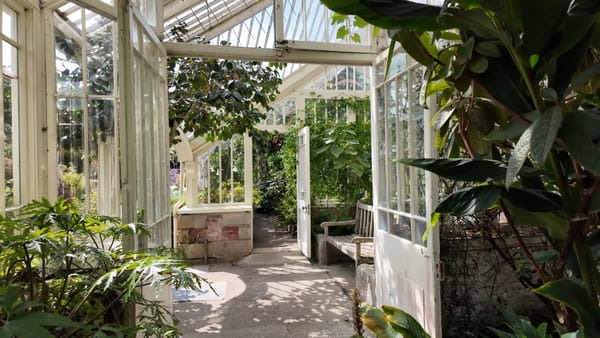There are nights when the moon rises over Cornwall in a way that feels almost too luminous, too perfect to be ordinary. The tide hushes, the hedgerows glow, and somewhere in the village, a kettle is boiling for a moonlit gathering. For generations, gardeners here have kept one eye on the soil and the other on the sky, timing certain plantings and rituals to rare lunar events — the blue moon, the supermoon, and the eclipse. Whether you follow the moon’s influence for spiritual reasons, folklore, or simply for the pleasure of marking time in a more poetic way, these rare events offer moments to pause, plant, or prune with intention.
The Blue Moon: Sowing Rarity and Hope
A blue moon is the second full moon in a single calendar month, a quirk of time that happens only once every few years. In Cornwall, it has become a moment for gardeners to sow something that matters — not just in terms of harvest, but in meaning.
Local tradition suggests planting seeds that carry a sense of rarity or symbolism: a treasured heirloom vegetable, a pollinator plant you’ve been saving for the right moment, or a blue-flowered beauty like Agapanthus ‘Blue Moon’, Lobelia, or Ceanothus. There’s an unspoken poetry in aligning rarity with rarity.
In some parishes, gardeners organise “once-in-a-blue-moon” seed swaps under lantern light, trading cuttings and seedlings alongside cups of hot tea. Herbs harvested that night are often dried for winter infusions, with the belief that their flavour — or perhaps their charm — is stronger for having absorbed the blue moon’s glow.
Practical tip: Use a blue moon for planting crops or flowers you hope will become standouts in your garden. Avoid rushing — the magic is in the slow, deliberate act of planting with intention.
The Supermoon: Planting in Amplified Light
When the moon swings closer to Earth in its orbit, it appears larger, brighter, and somehow more present. A supermoon can pull more than just the tides — for many gardeners, it pulls them outdoors, trowel in hand.
Lunar gardening calendars often suggest that the supermoon’s strong gravitational influence and extra light make it a good time for sowing or transplanting fruiting and flowering plants. In Cornwall, that might mean tomatoes and runner beans for the veg patch, or fragrant annuals and hardy perennials for the borders.
Some community gardens host “supermoon sow-ins,” where neighbours plant together beneath the silver glow, often followed by a shared meal or a moonlit walk through the lanes. Photographers wander down to the cliffs to capture the moon rising over the sea, while gardeners take quieter pleasure in seeing their beds bathed in light.
Practical tip: Plant above-ground crops during the supermoon — beans, squash, annual flowers, and perennials ready for moving. If you can, work without artificial lights to let your eyes adjust to the moonlight and the slower rhythm it brings.
The Lunar Eclipse: A Pause for Renewal
While blue moons and supermoons invite activity, lunar eclipses signal something different — a pause. In Cornwall, these shadowed moons are treated as moments for letting go rather than beginning. Gardeners avoid sowing, transplanting, or major harvesting, believing the eclipse to be a time of unsettled energy.
Instead, the work is reflective: pruning out what is spent, turning the compost heap, or clearing beds for the next cycle. Some gardeners mark the event with a small ritual — writing down gardening disappointments and adding them to the compost pile, or tying herb bundles as symbols of closure.
Gatherings often take on a quieter tone: “eclipse teas” served in mugs that steam in the cool night air, fireside folklore about the moon’s shadow, and long silences watching the light return.
Practical tip: Use eclipses for restorative tasks — composting, pruning, and deep weeding. See it as an interlude, a moment to reset your garden’s rhythm.
A Cornish Way of Marking Time
In the softer climate of Cornwall, where gardens grow nearly year-round, rare lunar events act as natural markers in the seasonal cycle. They give shape to the gardening year in a way that is less about the clock and more about the story.
While scientific evidence linking these moons to plant performance remains slight, their value lies elsewhere: in the mindfulness they encourage, the traditions they carry, and the gatherings they inspire. For some, the act of planting under a blue moon feels like a promise to the future. For others, an eclipse becomes a symbolic sweeping away of the old to make space for the new.
In both private gardens and shared allotments, these nights are a reminder that gardening is not just about cultivation, but about connection — to the land, to the sky, and to each other.
Quick Reference for Rare Moon Gardening in Cornwall
| Event | Best Activities | Avoid |
|---|
| Blue Moon | Sow rare or symbolic seeds, harvest herbs for preservation, host seed swaps | None, but choose plantings with intention |
| Supermoon | Plant or transplant above-ground fruiting and flowering crops, hold communal sowings | Root crops (better in waning moon) |
| Lunar Eclipse | Prune, compost, weed, set intentions, reflect | Planting, sowing, major harvesting |









